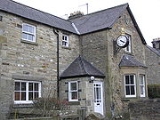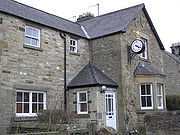
Aldbrough, North Yorkshire
Encyclopedia
Aldbrough St John is a village and civil parish
in the Richmondshire
district in North Yorkshire
, England
. The parish has a population of 325 (2001 census).
language Aldbrough means "Old Burh" or fortified stronghold. At one time, Aldbrough-st-John had a "small castle". We know this from John Leland's account in 1540 that "There appere great ruines of a howse or litle castel at Albruch village, and thereby rennith a bekke. It standith a 2 mile south from Perse Bridg on Tese" Perse Bridg is now called Piercebridge
2 miles north of Aldbrough referred to above as Albruch. If this "castle" was indeed a ruin by 1540, then it must surely have dated from long before.
When the Duchess of Northumberland came to live in the village in the late 1800s, she had many of the old properties removed and the stone used to build new houses. It is generally accepted that any castle remains were also removed at this time. The foundations of this building were recently found by local historians in what is believed to have been the "burh" oval. A property of this type within the village is thought by Ian Wardle - one of our historians - to be the reason why Aldbrough not only kept, but increased in value in Norman times when all villages around were sacked and burned. He believes that Aldbrough was at the centre of the lands occupied by the local lord so may have been spared. This information is further expanded on the village website

Civil parish
In England, a civil parish is a territorial designation and, where they are found, the lowest tier of local government below districts and counties...
in the Richmondshire
Richmondshire
Richmondshire is a local government district of North Yorkshire, England. It covers a large northern area of the Yorkshire Dales including Swaledale and Arkengarthdale, Wensleydale and Coverdale, with the prominent Scots' Dyke and Scotch Corner along the centre. Teesdale lies to the north...
district in North Yorkshire
North Yorkshire
North Yorkshire is a non-metropolitan or shire county located in the Yorkshire and the Humber region of England, and a ceremonial county primarily in that region but partly in North East England. Created in 1974 by the Local Government Act 1972 it covers an area of , making it the largest...
, England
England
England is a country that is part of the United Kingdom. It shares land borders with Scotland to the north and Wales to the west; the Irish Sea is to the north west, the Celtic Sea to the south west, with the North Sea to the east and the English Channel to the south separating it from continental...
. The parish has a population of 325 (2001 census).
History
In NorseOld Norse
Old Norse is a North Germanic language that was spoken by inhabitants of Scandinavia and inhabitants of their overseas settlements during the Viking Age, until about 1300....
language Aldbrough means "Old Burh" or fortified stronghold. At one time, Aldbrough-st-John had a "small castle". We know this from John Leland's account in 1540 that "There appere great ruines of a howse or litle castel at Albruch village, and thereby rennith a bekke. It standith a 2 mile south from Perse Bridg on Tese" Perse Bridg is now called Piercebridge
Piercebridge
Piercebridge is a village and civil parish in the borough of Darlington and the ceremonial county of Durham, England. It is situated a few miles west of the town of Darlington. It is on the site of a Roman fort of AD 260-270, which was built at the point where Dere Street crossed the River Tees....
2 miles north of Aldbrough referred to above as Albruch. If this "castle" was indeed a ruin by 1540, then it must surely have dated from long before.
When the Duchess of Northumberland came to live in the village in the late 1800s, she had many of the old properties removed and the stone used to build new houses. It is generally accepted that any castle remains were also removed at this time. The foundations of this building were recently found by local historians in what is believed to have been the "burh" oval. A property of this type within the village is thought by Ian Wardle - one of our historians - to be the reason why Aldbrough not only kept, but increased in value in Norman times when all villages around were sacked and burned. He believes that Aldbrough was at the centre of the lands occupied by the local lord so may have been spared. This information is further expanded on the village website


